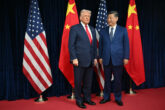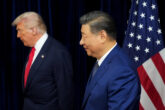September 20, 2018
Power Play
Addressing China’s Belt and Road Strategy
Executive Summary
The United States and China are in a competition to shape the course of the 21st century. At stake is whether the prevailing international order that has backstopped peace, prosperity, and freedom will endure, or whether Beijing’s emerging vision – a world defined by great power spheres of influence, rigged economic interactions, and ascendant authoritarianism – will become the global reality.
To realize this vision, China is making multiple power plays. It has worked assiduously to offset long-standing American military advantages by transforming the People’s Liberation Army (PLA) into a force tailored to exploit perceived U.S. vulnerabilities.1 China has also employed economic coercion against American allies and partners to modify their behavior to suit its interests.2 And Beijing has systematically acquired foreign technology through legal and illegal means with the objective of dominating the innovation industries of the future.3
Then there is what China calls “One Belt, One Road,” its newest power play combining economic, diplomatic, military, and informational instruments of statecraft. This Belt and Road strategy envisions a more connected world brought together by a web of Chinese-funded physical and digital infrastructure. Beijing has dedicated enormous resources to this strategy; independent estimates put total Belt and Road-related construction and investment at around $340 billion from 2014 to 2017.4 Yet the Belt and Road should not be viewed as a 21st-century Marshall Plan with Chinese characteristics. Although addressing a genuine demand for infrastructure, this strategy is designed to lay the foundation for an alternative order and is already eroding international norms and standards in a way that privileges China.
How the Belt and Road is Reshaping the World
Despite confronting growing resistance in some countries, the Belt and Road is having real-world effects that extend from geopolitics to commerce to governance and development.
China will cement its status as a global power.
- Dual-use facilities constructed under the banner of the Belt and Road will enable the PLA to increasingly operate globally. This will create new risks for U.S., ally, and partner militaries operating in the Indian Ocean Region (IOR) and beyond.
- China will attain lasting diplomatic leverage across a large part of the world by offering infrastructure financing to some governments at a level exceeding their ability to repay.
- China’s ability to manipulate global supply chains for geopolitical benefit will grow. In a crisis or conflict, it could create artificial market scarcities as a new form of economic coercion.
- European cohesion on China policy will continue to weaken as Belt and Road investment into Southern and Eastern Europe incentivizes countries to minimize positions at odds with Beijing.
China will place the world economy at risk while strengthening its ability to compete.
- International commercial standards will come under pressure as China races to execute infrastructure projects and moves to create a new legal architecture associated with the Belt and Road.
- The Belt and Road will provide China’s information technology sector with a significant edge by enabling Beijing to set online standards and establish new platforms while tapping data and talent overseas.
- Key countries will confront significant risk of debt distress given that most of China’s financing for Belt and Road projects is loans.
- Non-Chinese companies will compete for Belt and Road contracts on an uneven playing field and participate in projects on Beijing’s terms. China will attempt to externalize some of the financial risk associated with Belt and Road projects by inviting Western investors.
China will imperil democracy in some countries and promote low-quality development.
- Countries taking Chinese investment under the Belt and Road run a high risk of governance declines, in part because many lack strong institutions, and because corruption and the resulting capture of elites can serve as a tool for Beijing to secure projects with strategic potential.
- The Belt and Road will serve to exports elements of China’s digital surveillance regime as Beijing promotes information connectivity to complement physical infrastructure.
- Beijing advances a “China First” development model that maximizes its economic interests while offering minimal capacity building to countries receiving investment. Local environmental and human rights concerns will be ignored.
Addressing China’s Power Play
The United States today lacks a coherent and well-resourced response to China’s Belt and Road strategy. Unadulterated opposition would prove counterproductive, given that many countries welcome infrastructure investment from any quarter – even with strings attached – and see few credible alternatives to working with China. Accordingly, the United States in concert with its allies and partners should adopt an approach that seeks to shape the Belt and Road where possible, compete when required, and most critically, advance a positive economic vision.
This approach should include the following key elements:
Recommendations: Getting Fundaments Right
- Advance a compelling American agenda for international development, trade, and investment. The United States should immediately launch a series of forums across the Indian Ocean rim and Eurasia to showcase America’s commitment to high-quality development cooperation leveraging U.S. strengths such as entrepreneurship.
- Develop and execute a counternarr ative to China’s Belt and Road. This starts by forging a robust non-military public diplomacy capability, re-creating aims and functions of the Cold War-era U.S. Information Agency, optimized for the digital age.
- Resource all elements of an American response. Congress should significantly raise the cap on lending by the Overseas Private Investment Corporation (OPIC) and allow the U.S. government to take equity in overseas projects by swiftly passing legislation such as the Better Utilization of Investments Leading to Development (BUILD) Act.
Recommendations: Geopolitics
- Align strategic infrastructure investments. This begins with the United States, Japan, Australia, India, France, and the United Kingdom prioritizing locations and infrastructure projects in the Indo-Pacific based on their combined economic and military value.
- Play defense and offense on military posture in the Indian Ocean. As an initial step, the United States should convene defense planners from Japan, Australia, India, France, and the U.K. to identify one or more locations in the region that could become shared military hubs.
- Launch a supply chain dialogue. The United States should invite its advanced economy allies to participate in a new, quiet dialogue on how to mitigate the risk accompanying China’s growing control over global supply chains.
Recommendations: Commerce
- Expand U.S. digital outreach. The United States should work with Europe and Japan to establish a digital development fund under the auspices of the Organisation for Economic Co-operation and Development (OECD). In addition, the Department of Commerce’s Digital Attaché Program should be expanded to a wider set of countries.
- Promote regional connectivity plans. The United States should partner with members of the Gulf Cooperation Council (GCC) to launch a new infrastructure initiative for the Middle East.
- Codify an international standard for high-quality infrastructure. Using the new standard, the United States should put forward a “high-quality infrastructure pledge” that global companies and investors could make.
Recommendations: Governance and Development
- Prepare to capitalize on moments of disillusionment with the Belt and Road. Focusing on countries hosting Belt and Road projects, the U.S. State Department should leverage artificial intelligence-powered sentiment analysis of local news and social media and American embassy reporting to create a database for use across the U.S. government that tracks mounting frustration with Chinese investment.
- Foster political resiliency in countries targeted for Belt and Road investment. In nations potentially vulnerable to Chinese capture of their elites, the United States should bolster rule of law, transparency, accountability, freedom of the press, and civil society.
- Enhance technical capacity in countries across the Indian Ocean rim and Eurasia. Partnering with India and the United Arab Emirates, the United States should establish an Infrastructure Center of Excellence in Dubai to train officials from the Middle East, Africa, and South and Central Asia.
With a Belt and Road backlash already evident in some countries, the United States has a window of strategic opportunity. In concert with like-minded allies and partners, it should seize the moment.
The full report is available online.
- Office of the Secretary of Defense, Annual Report to Congress: Military and Security Developments Involving the People’s Republic of China 2017, C-B066B88 (May 15, 2017), https://www.defense.gov/Portal... Documents/pubs/2017_China_Military_Power_Report. PDF?ver=2017-06-06-141328-770. ↩
- Peter Harrell, Elizabeth Rosenberg, and Edoardo Saravalle, “China’s Use of Coercive Economic Measures” (Center for a New American Security, June 11, 2018), https:// www.cnas.org/publications/reports/chinas-use-of-coercive-economic-measures. ↩
- Michael Brown and Pavneet Singh, “China’s Technology Transfer Strategy: How Chinese Investments in Emerging Technology Enable A Strategic Competitor to Access the Crown Jewels of U.S. Innovation” (Defense Innovation Unit Experimental, January 2018), https://admin. govexec.com/media/diux_chinatechnologytransferstudy_ jan_2018_(1).pdf. ↩
- Cecilia Joy-Pérez and Derek Scissors, “The Chinese State Funds Belt and Road but Does Not Have Trillions to Spare” (American Enterprise Institute, March 2018), https://www.aei.org/wp-content/uploads/2018/03/BRI. pdf. ↩
More from CNAS
-
Chinese Maker of Bitcoin-Mining Machines Is a Security Threat, Says Expert
Bloomberg News reports that a Chinese manufacturer, Bitmain Technologies Ltd, that sells most of the world’s Bitcoin-mining machines — including 16,000 of them to a venture ba...
By David Feith
-
Indo-Pacific Security / Energy, Economics & Security
North Korea’s Provocations, Power Plays, and Shifting AlliancesTensions on the Korean Peninsula have reached a new and dangerous threshold. President Lee Jae Myung is warning of a real risk of accidental military clashes, as the situation...
By Dr. Go Myong-Hyun
-
Indo-Pacific Security / Energy, Economics & Security
How to Win the Economic War with ChinaTrump's approach to China has run aground, giving Beijing unprecedented advantage in the economic conflict....
By Edward Fishman & Julian Gewirtz
-
Indo-Pacific Security / Technology & National Security
Sharper: Tech + ChinaRecent talks between President Donald Trump and Chinese Communist Party General Secretary Xi Jinping placed a spotlight on emerging technologies, from high-end chips to minera...
By Charles Horn & Sevi Silvia






